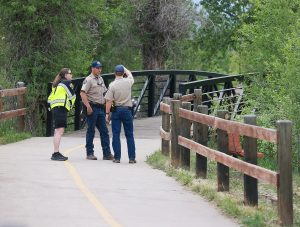Wildfire risk remains potent on Colorado’s Western Slope as summer heats up

Steamboat Springs Fire Rescue/Courtesy photo
As the Western Slope experiences the early-summer green up, persistent drought conditions and precipitation deficits across the region underscore the ever-looming wildfire danger.
The June 1 wildland fire outlook from the National Interagency Coordination Center is predicting that the majority of Colorado will experience “normal significant fire potential” through September.
The exception is southwest Colorado, which the outlook reports will have “increased significant fire potential in June,” following a dry winter. In July, as the monsoon intensifies and brings more frequent rainfall and thunderstorms, the region is expected to fall back to “normal wildfire risk” with the rest of the state. 2
Russ Schumacher, Colorado’s state climatologist, reminded that “even a ‘normal’ wildfire season is still a lot of fires.”
Already this year, northwest Colorado has seen multiple ignitions. Routt County fire crews have responded to multiple structure fires since mid-April In Eagle County, thunderstorms sparked four small fires as crews also battled a fire at a compost pit in Wolcott over Memorial Day weekend.
Summit County Fire & EMS responded to three wildfires in a two-week period in May.
These ignitions match the “typical seasonal trends” for the Rocky Mountain region, according to the June outlook.
“Lightning starts are starting to become more common, especially west of the Continental Divide where the fuels are more receptive,” the outlook states. “Despite the increasing activity and drying fuels, most fires have been contained within one operational period and (have) been less than 10 acres.”
Much of the Rocky Mountain region — which includes Colorado, Wyoming, Kansas, Nebraska and South Dakota — has seen fire danger values drop as showers and thunderstorms increase and the green-up hits its peak, according to the outlook.
However, it’s a slightly different story on Colorado’s Western Slope and in the state’s northwest corner.
“With the ongoing drought and less precipitation, the West Slope of Colorado is starting to see the grasses dry out and support more fire spread,” the outlook adds.
Schumacher added that while recent precipitation in southwest Colorado will go a long way in reducing wildfire risk as it recharges the soil and vegetation moisture, “Northwestern Colorado has had a significant precipitation deficit recently.”
“The U.S. Drought Monitor has shown degradations of two to three categories over the last month over Routt, Moffat and Rio Blanco counties, so that is an area that bears watching, especially since they don’t typically see as much benefit from the summer monsoon as areas farther south,” Schumacher said.
The May 29 drought monitor from the U.S. Department of Agriculture for Colorado shows the majority of northwest Colorado with some degree of drought from “abnormally dry” to “severe drought.”
Moderate drought conditions exist in the majority of Routt County with more severe conditions in the south and west reaches of the county.
Though less than southwest Colorado, the last few weeks have brought some precipitation to portions of the northwest, including Eagle and Summit counties, where conditions have been drying out in recent months.
In Colorado, monsoon activity starting in early July can bring heavy rainfall and thunderstorms, helping with fuel conditions and wildfire risk.
It’s still unclear when the monsoon will start this year, Schumacher said.
The June wildland fire outlook reports some indication it could start later than usual, while other forecasts predict an earlier start.
“The outlooks have been pretty consistent with the monsoon being active this year, especially in Arizona and New Mexico, and if it’s active there, then we will usually see periods of heavy rain in southwestern Colorado as well,” Schumacher said.
However, the effects of monsoon activity “really taper off as you go north of (Interstate 70),” Schumacher said. July and August precipitation in much of northwest Colorado is not as important to the total annual precipitation in the region as it is in places along eastern Colorado and even sections of the southwest, according to maps from Schumacher and the Colorado Climate Center.
As the outlook shows Colorado inching back toward a “normal” threshold of risk this summer, wildfire risk remains above normal potential in the northwest United States, which could have indirect impacts in the state.
“The wildfire outlook for the northwestern United States and Canada is quite concerning, so even if we don’t end up with a bad season locally, we should expect to see smoke in the air from those fires as the summer goes on,” Schumacher said.

Support Local Journalism

Support Local Journalism
Readers around Steamboat and Routt County make the Steamboat Pilot & Today’s work possible. Your financial contribution supports our efforts to deliver quality, locally relevant journalism.
Now more than ever, your support is critical to help us keep our community informed about the evolving coronavirus pandemic and the impact it is having locally. Every contribution, however large or small, will make a difference.
Each donation will be used exclusively for the development and creation of increased news coverage.









